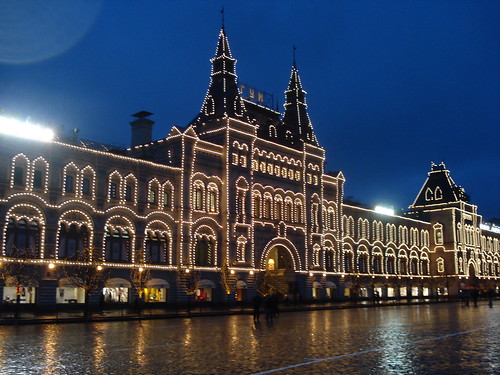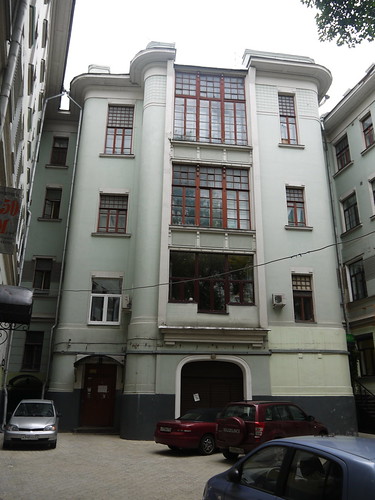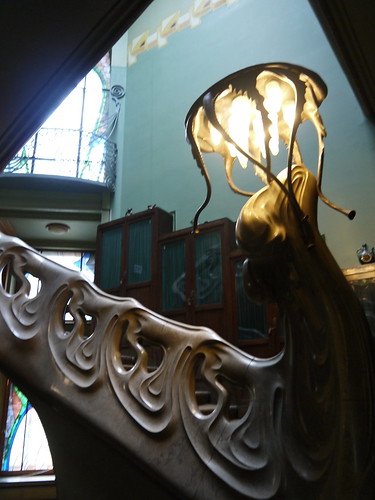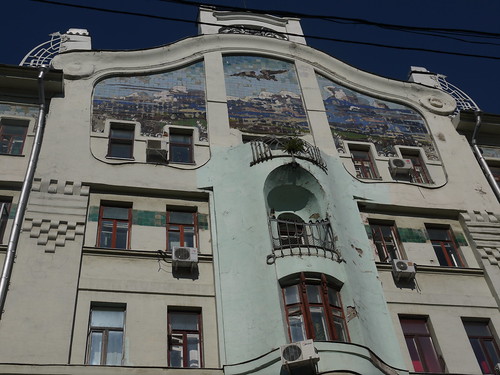I have to confess, despite considering it to be primarily for tourists, and knowing that its a place that Muscovites don't really hang out in, I love Red Square. From my very non-Russian point of view the square is Moscow - those fantastic onion domes of St. Basil's Cathedral - so imposing from the outside and relatively small on the inside; the views across to the Kremlin's domes from the square and the juxtaposition of Lenin's tomb together with the remains of several other Soviet leaders looking directly across at Moscow's once drab and now glitzy department store - GUM (pronounced "goom"). How ironic that Lenin and his comrades should come to rest looking at a symbol of the new capitalist Moscow - money and lots of it!
 |
| GUM by night |
This is a very expensive city. Eating reasonably well is not cheap. I am very fond of an Armenian restaurant - Cafe Ararat that sits in the lobby of the Hyatt Hotel. The food is good - this time I enjoyed lavash (the Armenian flat bread) together with herbs and soft curdy cheese, followed by a delicious lentil, walnut and herb soup, all washed down with apricot juice, Germuk - the slightly salty Armenian mineral water and followed by "sand" coffee and an Armenian take on creme brûlée. Extremely tasty, extremely satisfying, extremely expensive - the equivalent of fifty pounds - just for me, and with no alcohol!
Still, I enjoyed the food and the service was good, very good.This is not always the case in Russia where service can be outstandingly good (as at my hotel - the Metropol) or spectacularly bad. After dinner one evening I decided to have my coffee elsewhere and wandered into the Moscow branch of Le Pain Quotidien. OK so its an international chain, but its a good one and I fancied a nice coffee and a strawberry tart. Things did not go well. The waiter began by denying the existence of an English menu, which I could see lying on the next table, then pretty much refused to take any order for around 20 minutes by which point I had decided that there are other coffee shops in Moscow and left. On the way out I encountered the duty manager - a well turned out smiling young woman with good English. She seemed to find the incident amusing to the point of laughing out loud. I reassured her that it wasn't, pointing out the unintelligent example she was setting her staff. The laugh ceased and the lips turned into an inverted "U". Of course, I hated myself later for letting the incident annoy me, but this young woman didn't even have the excuse of not having learned any customer care skills in Soviet times. Rant now complete, thanks for listening.
Of course there is also a "third way" to service in some Moscow restaurants. My favourite which shall remain nameless was where a very keen, very smiley, very polite young waitress took my order for soup and asked me if I would also want dessert. I ordered ice cream which she then brought with a beatific smile. Great, except the soup hadn't arrived at that point. I asked about the soup and was told "wait". It came soon after. Well she tried.
As well as frequenting Red Square, getting cross in cafes and enjoying my lovely hotel, I took advantage of an unusual guided walk. I have recently read Bulgakov's The Master and Margarita after having seen the Thetare de Complicite's stage performance earlier this year. Intrigued by what a "Bulgakov tour" might involve, I signed up. The walk retraced the steps of the Master and Margarita's plot, including the Patriarchs Ponds (incidentally there is only one pond, so not sure why it has a name in plural), a chance to sit on the bench where Woland first met Berlioz (not the composer) and Bezdomny. OK so I know its not the bench, but I like the idea that someone has gone to the trouble of trying to work out where that particular bench would have been situated.
You then get to see the point in the road, where as predicted the young woman spills cooking oil, Berlioz slips in it and is killed by an on-coming tram being driven by a woman. Great detail, even if the guide did advise me that it seems no tram ever ran through this square. Has he never heard of the willing suspension of disbelief? The tour goes on to include a peep at the house alleged to have been Margarita's when she lived with her husband. It is generally believed that Margarita was based on a real life character who shared that house with her real life husband - a senior Communist Party official!
Best of all is the Bulgakov House Museum where the tour ends. The museum is located in the apartment that Bulgakov once occupied on the Garden Ring. The apartment is reached through climbing several sets of stairs. The stairwell is decorated with graffiti related to the Master and Margarita, some of it extremely well done and witty. Apparently the residents in the rest of the block do not like this, seeing it as vandalism and regularly painting over it, much to the chagrin of my guide.
The apartment has a series of rooms, recreating the Soviet Moscow of the 1920's and 1930's, with its shared approach to living - several families would have lived here, each with a tiny space of their own and sharing the dark kitchen. Communal living offered few opportunities for privacy, many for snooping and spying (with the encouragement of the state of course) and resulted in many disagreements between tenants, including over the alleged theft of food!
 |
| Courtyard of the apartment block where Bulgakov lived |
Bulgakov's writing room is re-created with copies of the original furniture. Do not be taken in by the large black cat laid sleeping on the desk. It is real, as several other visitors found to their surprise when touching him to check! Behemoth reincarnated perhaps? The museum does Bulgakov tours by arrangement. Beware of the rival museum on the ground floor in the courtyard of this building - it has no real links with Bulgakov and contains no original furnishings or other items.
I have already written about constructivist architecture in Moscow here, but I also find the city's Style Moderne architecture thrilling. Style Moderne was the Russian take on art nouveau and one of the best examples of this is the Gorky House Museum, originally known as the Ryabushinsky Mansion, completed in 1902 and designed by Feodor Shekhtel, one of Russia's greatest ever architects. The original residents fled the Bolsheviks who used the house as an administrative building until it was given to author Maxim Gorky in 1931. Gorky is reported to have disliked the house which only goes to show that even great artists often lack taste in other people's fields.
 |
| Detail of the Ryabushinsky Mansion staircase |
The city has many other Style Moderne buildings as well as buildings in the "Neo-Russian" style which also paid tribute to art nouveau. Some of these are hidden in relatively ordinary streets and can either be missed if you don't have your wits about you or take some finding even if you know about them. One of my other favourites is the the former Moscow dormitory for visiting Orthodox priests, hidden behind Tvertskaya Boulevard. Once facing directly on to the main road, the building was enclosed by new structures when Stalin decided to remodel Tvertskaya as part of his new look Moscow. Now tucked away behind some fairly nondescript buildings it is well worth searching out and admiring. I love the multi coloured tiles and interesting features it boasts, especially the detail around the windows.
Also tucked away is the Sokol building at Mashkov 94, built 1902-03 and designed by Ivan Mashkov. The round bay on the house's facade is set off with extremely ornate ironwork whilst the large ceramic panels at the apex of the house, designed by Nicola Sapunov, show a falcon flying over snow-capped waves. Sokol is the Russian word for falcon. These panels were the subject of a lawsuit between the designers of the Metropol Hotel and Mashkov, both claiming to have been plagiarised by the other. The Metropol won out. If you want to know more, there is a great book by Kathleen Berton Murrell called "Moscow Art Nouveau". Its very difficult to get hold off and dreadfully expensive, but just leafing through my precious copy to check some of my dates here has made me want to return to Moscow to explore further.
 |
| Sokol building |
This post began in Red Square. It is headed "Midnight in Moscow". Why? well, I happen to be addicted to the tune of the same name, written by Vasiliy Solovyov-Sedoi and Mikhail Matusovsky in the 1950's and originally entitled Leningrad Nights, I have associated the tune with Red Square ever since hearing it as a small child and seeing images of St. Basil's. And not just this. One night when leaving the Cameri Theatre in Tel Aviv, I came upon at least 100 couples of mainly older people dancing to this music in the square and for some reason felt extremely touched. So, I always wanted to hear the tune in Red Square at midnight. I might have had to settle for hearing it on my i-pod, but I did it and if I say so myself, took a rather nice picture of the GUM department store to prove it!
This is such a thought-provoking post. It’s clear you’ve put a lot of effort into this, and it really shows. Thanks for sharing!
ReplyDeletebackyard pods melbourne